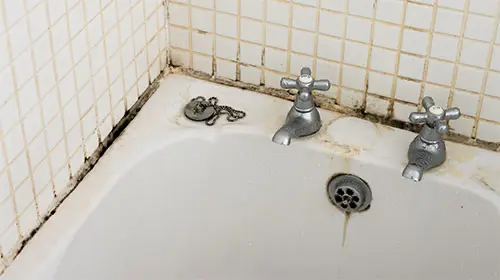Mold in Bathroom

Your bathroom should be a haven of rest and relaxation, and a clean, hygienic bathtub contributes to that feeling. And although you keep your tub clean, mold can still infect your bathroom and spoil its look as well as present health hazards.
Mold in the bathroom can vary in color from dark brown or green to black. Some varieties may have a blue, green or yellow tinge. Active mold is soft and slimy or fuzzy and may smear easily. It releases spores into the air, and these can spread throughout the room and into other parts of the house. Mold can cause a number of health issues, so it’s important to be aware of it and treat it promptly.
Bathrooms are especially prone to mold formation because of the humid conditions that are naturally present, so regular cleaning is often not enough to prevent or stop it. Further steps might be necessary to eliminate it completely.
The most common places for mold growth are the seam between the tub and wall, in the corners of the tub, and in tile joints. These areas are also more difficult to clean. It can be especially hard to remove mold from porous surfaces because the mold gets trapped in the pores and can spread.
CAN BATHROOM MOLD INDUCE ILLNESS?
For most people, a little mold is not a cause for concern. However, for those who are sensitive to it, it can worsen allergies and asthma. In people with a pre-existing respiratory condition or a compromised immune system, it can cause severe allergies or even activate an autoimmune condition.
Common reactions of people who are affected by mold exposure include nasal congestion, throat irritation, coughing, and eye discomfort.
In any case, you definitely want to rid your bathroom of mold. So let’s dive in and learn more about it and how to keep it from infesting your bathroom and affecting your life.

WHAT CAUSES MOLD?
The root cause of mold is mainly humidity. The bathroom is naturally the room where more water is used than any other room in the house. Reducing moisture actually starts during the planning stages even before the construction of a home, or during a home remodeling project. Proper ventilation, using mold-resistant materials, and a well-designed HVAC system can all contribute to mold prevention.
Lack of light contributes to the growth of mold, since it prefers dark environments. Many bathrooms do not have a window, or only a small one, and lights are generally turned off soon after bathing or showering.
Poor ventilation and poorly designed HVAC systems hold the moisture in the bathroom for long periods of time without allowing it to dissipate, giving the mold more opportunity to take hold and grow.
Leaks in plumbing can leave standing water where microbes can grow.
Cracks in walls, tiles, caulking and fixtures allow water or moisture to seep below the surface, leading to mold growing inside or behind the walls or fixtures.
Mold may be present even if it is not visible. If your bathroom has a musty smell, that may be an indication that it is present and needs to be dealt with.
HOW TO PREVENT MOLD
Since mold thrives in dark, humid areas, the first step is to eliminate those conditions.
-
Building materials and room design can make a big difference:
Well-sealed tiles and joints can prevent leaks. Cracked molding is a giveaway that you likely have leakage behind the tiles where mold is growing. If that’s the case, the caulking needs to be removed, the area cleaned and disinfected, and the caulking and sealant re-applied. Grout with a latex additive has greater strength and water resistance, and it can be used for larger grout joints.
Paints with mold inhibitors can be used to keep walls free of mold, but first any existing mold needs to be eliminated.
Mold-resistant drywall or greenboard is designed for use in high-moisture areas, so it is ideal for bathrooms.
-
Watch for places that water may be leaking or may build up:
Check pipes, plumbing and the floors and areas around fixtures for any signs of leakage.
Use shower doors or a shower curtain to keep water from splashing outside the shower stall.
Seal the edge of the tub where it meets the wall.
-
Take care to dry out the bathroom after bathing or showering:
Use a squeegee on shower walls and glass doors. This greatly reduces the moisture that promotes the growth of mold.
Run your bathroom fan while showering or bathing and for 15 minutes afterward.
If there is a window in the bathroom, open it. Even a small amount of outside air can increase ventilation. If possible, open the door also.
A dehumidifier can help if your bathroom is especially humid.
-
It may not seem important, but light is also an effective weapon against mold:
Leave lights on for 10 to 15 minutes after bathing or showering.
Besides opening the window, open blinds or curtains to let natural light in.
-
Resurfacing your bathtub with a strong, smooth finish can help protect from mold:
Cracks, chips and peeling can retain moisture which in turn harbors mold. A smooth, even finish repels microbes and doesn’t give them a chance to attach to the surface.
Bathtub reglazing with liquid acrylic using the pour-on method repairs underlying damage and creates a tight seal that repels water and keeps the surface mold-free. It gives the tub a like-new finish that lasts for years and resists stains, mold, and cracks.
Mold can often show up at the joint where the tub meets the wall or in the corner of the tub. Professional refinishing technicians can seal these areas. Sealing them tightly keeps water from seeping in and letting moisture build up, which in turn inhibits mold growth.
-
Regular cleaning and maintenance:
Use cleaners designed specifically for bathrooms.
Wash bathroom rugs and shower curtains regularly. Hang up towels to dry after each use and wash them frequently.
HOW TO GET RID OF MOLD
If you already have mold in your bathroom, there are a number of treatments available, both professional and do-it-yourself. The choice will depend on the severity of the problem and your personal preferences.
If you want to remove it yourself, you can first try one of these natural solutions. Always use appropriate personal protection: disposable gloves and a respirator or mold safety mask. Not only do you need to protect yourself from possible caustic fumes, but also dangerous spores from the mold can be released into the air. If there is a window, open it for ventilation.
Tea tree oil – This eco-friendly essential oil has antifungal and antibacterial properties. A little can go a long way, so it can be a cost-effective remedy.
How to use: Combine 1 teaspoon tea tree oil with one cup of water in a spray bottle. Shake to mix thoroughly. Spray on affected areas and wipe clean. It can also be used to prevent mold. Use the same mixture and spray on tiles, faucets, spouts and drains. Let air dry.
Distilled white vinegar – A great option because of its low cost and low impact on the planet. It works on several types of household molds.
How to use: Use it straight or mix in some lemon juice to lessen the strong smell. Pour into a spray bottle and spray directly on the mold. Let it set for at least an hour, then scrub with a soft-bristled brush and wipe clean.
Baking soda – A common item in most kitchens, its antimicrobial properties may kill mold and mildew in your bathroom.
How to use: Make a paste by mixing it with water and applying it directly to the affected area. Leave it on for at least 10 minutes and then scrub it off.
Bleach – A powerful disinfectant that can kill mold spores if less-potent, natural methods don’t work.
How to use: Mix one teaspoon of bleach with one cup of water and apply to affected area. Let stand for 10-15 minutes, then scrub with a brush to remove the mold.

If these DIY solutions don’t work, it’s time to call a professional.
If you find mold in your bathroom, contact the specialists at New York Tubs. Our technicians can identify and eliminate the cause of your mold issues. They can replace defective plumbing, modify the HVAC system, clean and eliminate existing mold and refinish the surface of your tub to protect it from future mold growth.

A bathtub refinishing expert with over 10 years of experience and founder of CityTub Inc., specializing in eco-friendly pour-on reglazing methods. Shares hands-on knowledge, techniques, and insights to help achieve professional, long-lasting results.
